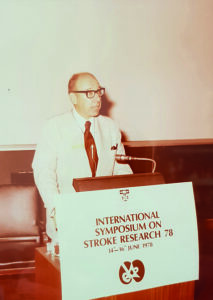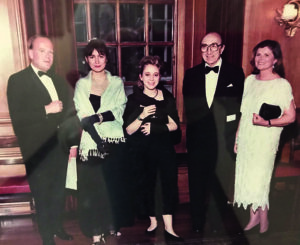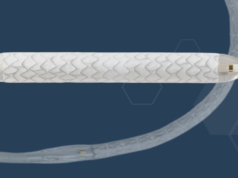
The occasion of a seminal meeting held in Chicago by former Society for Vascular Surgery (SVS) Presidents John J. Bergan, MD, and James S.T. (Jimmy) Yao, MD, played a central role in the formation of the world-renowned Charing Cross (CX) International Symposium, which this year marks its 45th edition.
The year was 1976, and Roger M. Greenhalgh, MD, CX founder and chairman, had not long returned from a tour of the world’s major vascular surgery centers, when he was invited to attend the Bergan and Yao meeting at Northwestern University. The brilliance of that educational meeting, said Greenhalgh, inspired him to create something similar back in London, England, where the then-young vascular surgeon, soon-to-be surgery department chair, would birth the CX Symposium at Charing Cross in 1978.
“John Bergan was a master of education,” remarked Greenhalgh. “I tried to do what he and Jimmy Yao did. Jesse Thompson, from Dallas, came to the first CX meeting in 1978, which was focused on progress in stroke research. Even now, we have an acute stroke session, but the first was entirely about that area.”
Every year since, Greenhalgh recalls, he has been invited to the U.S. “and learned from the giants,” drawing particular attention to Houston, “the mecca of vascular surgery,” and its most famous cardiovascular son, Michael E. DeBakey, MD, with whom he had spent time the year prior to attending the Northwestern meeting. “Nothing after that equalled that amazing experience,” he said. “There was no comparison between the quality of care there seen anywhere else in the world.”

Thus, the CX cornerstone was laid. Over the years, the symposium was the setting for key moments in vascular surgery history. The European Society for Vascular Surgery (ESVS) was convened at the meeting in 1988, with DeBakey involved in prompting vascular societies of Europe to form a pancontinental group, Greenhalgh noted.
In the same decade, Andreas Grüntzig, MD, attended CX to talk about his version of a new balloon angioplasty system, and the symposium was an incubator for the development of key randomized-controlled (RCT) trials, such as the UK Small Aneurysm Trial, EVAR 1 and 2, and IMPROVE.
In keeping with this long-standing tradition for being a theater for presentation and discussion of landmark advances in vascular care, this year will see CX play host to delivery of the first results from the much-anticipated BASIL-2 (Bypass versus angioplasty in severe ischemia of the leg-2) trial. They will be revealed by chief investigator Andrew Bradbury, MD, from the University of Birmingham in Birmingham, England, in the presence of representatives of the BEST-CLI (Best endovascular versus best surgical therapy for patients with critical limb ischemia) trial. A roundtable discussion is planned to include invited commentary from Eleni Whatley, from the U.S. Food and Drug Administration (FDA), and the British Secretary of State for Health, Steve Barclay. “At the moment of speaking, publication of the results will take place in The Lancet, which is a huge moment for CX,” he said. “We have had 45 years of a very global CX, and the tradition continues.”
Looking ahead, Greenhalgh believes one of the most pressing issues facing the vascular world is that of patients with a “hurting leg” not being seen by a professional in a timely manner. “My personal interest, not as yet proven, is a suspicion that patients whose legs hurt are at risk of amputation, and it is the responsibility of the vascular profession to do something about it,” he said.
Greenhalgh says he is not talking about patients who are referred to vascular specialists, but instead “the people who are not yet patients, whose legs hurt,” and who might not get advice from a doctor “simply because they think it is the aging process and they do not need to.” He continued: “They live in such an environment where they somehow do not get the advice that would enable them to have something done that would save their legs.”
He references “interesting data” on the subject from Naseer Ahmad, MBChB, from Manchester Royal Infirmary in Manchester, England, which “would seem to suggest that in parts of the population where there is poverty, or inadequate facilities, that these are the areas in which the ‘hurting leg’ does not get the attention it should.” Suggesting what can be done to address this, Greenhalgh stresses that it is important to throw light upon this issue “in order to be able to get more people to get more timely intervention and have their leg saved.”
On the occasion of the 45th anniversary of CX, Greenhalgh ponders what is coming next for the meeting. In particular, he emphasizes the importance of future planning to ensure the concept of CX—education, innovation and evidence—continues.
To that end, he has recently appointed three new co-chairs to the CX leadership team who will work alongside him to deliver the CX program going forward: Dittmar Böckler, MD, medical director of the Clinic for Vascular and Endovascular Surgery at University Hospital Heidelberg in Heidelberg, Germany; Andrew Holden, MD, director of interventional radiology at Auckland City Hospital in Auckland, New Zealand; and Erin Murphy, MD, director of the Venous and Lymphatic Institute at Sanger Heart and Vascular, Atrium Health in Charlotte, North Carolina. “We are covering the globe and all vascular subjects,” Greenhalgh said of the new leadership team. “There will be every opportunity for the CX concept to continue if that is considered to be worthwhile doing.”
The CX anchor points to what he sees as one of the central pillars of the CX brand: its multidisciplinary appeal. “If you have an interest in—and are managing patients with—vascular disease,” he says, “there is something for you at CX.” This multidisciplinary approach is particularly important for the education of the next generation, Greenhalgh believes. “It is important to get as much experience alongside as many people as you can, so that you become a compendium of all those people that you have learned from,” he added.












